Immerse in the Bedouin Oasis Camp Experience


Intro
The Bedouin oasis camp experience is a fascinating fusion of tradition, culture, and hospitality, nestled within the arid vastness of the desert. These camps are not just simple accommodations; they embody the history and values of the Bedouin people, serving as a gateway into a world steeped in rich heritage and age-old practices. A visit to these camps opens up a dialogue between past and present, offering tourists a glimpse into the intertwining of desert life and modernity.
The idea of spending a night under the starlit sky, wrapped in the warm embrace of tradition, warms the heart. As you step into an oasis camp, a unique sense of calm engulfs you. The gentle rustle of palm fronds, paired with the muted conversations of fellow campers, creates a symphony of serenity. From traditional Arabic coffee shared in the shadows of the tents, to the enchanting dances around the fire, each moment spent here tells a story, drawing on centuries of communal wisdom and hospitality.
Delving deeper, this experience offers activities and interactions that resonate with the earth. Picture yourself riding camels across golden dunes, or setting out with local guides who narrate the lore of the desert. The shared laughter and the stories exchanged enhance the feeling of connection with a culture that values community above all.
Through this exploration, we aim to shed light on what makes these Bedouin oasis camps significant not just as destinations, but as living examples of sustainability and cultural continuity. By embracing different aspects of life in these camps—from architectural features to the authentic culinary experiences—readers can truly appreciate the balance of leisure and functionality they offer.
As we unfold this narrative, you'll find insights that lead beyond mere tourism. With the right perspective, a journey into a Bedouin oasis camp can evolve into a profound appreciation for the heritage and lifestyle found within the Middle Eastern deserts.
Prologue to Bedouin Culture
The significance of Bedouin culture resonates deeply within the context of the desert's harsh yet enchanting landscape. This introduction aims to lay the groundwork for understanding not just the Bedouins' way of life, but also the hospitality that has become synonymous with their identity. The Bedouin people, who have called the arid expanses their home for centuries, carry a wealth of traditions that reflect survival, adaptability, and an intricate relationship with their environment.
Historical Roots
The history of the Bedouin is as vast as the deserts they inhabit. Originating from Arabian Peninsula over a thousand years ago, they encapsulate a rich tapestry of stories that reflect resilience and deep-rooted values. Their societal structure has largely revolved around tribes, with lineage and kinship guiding interactions. This tribal system not only fosters a sense of belonging but also reinforces the importance of unity in a world often fraught with hardship.
"The men and women of the Bedouin tribes are more than mere survivors; they are custodians of their own narratives, which unfold against a backdrop of shifting sands and starlit skies."
The Nomadic Lifestyle
The Bedouin lifestyle is characterized by its nomadic nature, which is a testament to their adaptability. Living in tents, typically made from goat hair, allows for portability and protection from the elements. Their mobility is not just a way of life; it is a strategy born from the need to find fresh pastures for their livestock.
In this nomadic existence, Bedouins follow seasonal patterns, transitioning between different areas in search of sustenance. This dance with the earth teaches them respect for nature and an acute awareness of their surroundings. Community gatherings, storytelling, and ceremonial events fortify their culture, creating a unique blend of connectivity and continuity.
Understanding these historical roots and the nomadic lifestyle helps illuminate the depth of what it means to experience a Bedouin oasis camp. Each element—from their architectural choices to their unique culinary traditions—is a window into a way of life that has both shaped and been shaped by the desert.
Understanding the Bedouin Oasis Camp
The Bedouin oasis camp serves as a microcosm of Bedouin culture and hospitality, intricately woven into the very fabric of desert life. To grasp the essence of these camps, one must delve into their unique architectural features and the cultural significance they embody. Understanding the Bedouin oasis camp not only sheds light on the historical context but also reveals how these spaces adapt to modern needs while maintaining their roots.
Architectural Features
The architectural layout of a Bedouin oasis camp is both practical and symbolic. At its core, the structure often consists of traditional black goat hair tents, known as "beit al sha'ar," which serve a dual purpose: they are functional shelters against the harsh desert climate and a reflection of Bedouin artistry. The tents are designed to be easily assembled and disassembled, accommodating the nomadic lifestyle of the Bedouin people.
In addition to tents, oasis camps often feature communal spaces that foster interaction among guests. Open-air majlises (sitting areas) with intricate carpets and cushions are common, providing places for storytelling and bonding. Each corner of the campsite is thoughtfully arranged, offering visitors a slice of traditional living while ensuring comfort.
"In every tent, there lies a story, in every rug, a shared moment. The architecture of a Bedouin camp tells of a life led under the vastness of the desert sky."
Cultural Significance
Culturally, the Bedouin oasis camp is a vital link between generations. These camps are not just places to stay; they are venues for preserving traditions and fostering community. The hospitality extended to guests is a core value among Bedouins, rooted in a deep sense of honor and respect for visitors.
Moreover, the camp’s setup reflects societal values—each element, from the cuisine to the textile patterns, holds significance. The mixing of family and visitors exemplifies the Bedouin philosophy of generosity. Attending ceremonies, music performances, and culinary experiences at the camp enables one to witness the Bedouins’ hearty embrace of their cultural heritage.
In summary, the explorations of architectural features and cultural significance of the Bedouin oasis camp reveal much about the essence of Bedouin life. They encapsulate a unique blend of tradition and practicality, making these camps a cornerstone of the desert experience.
Key Elements of the Oasis Camp
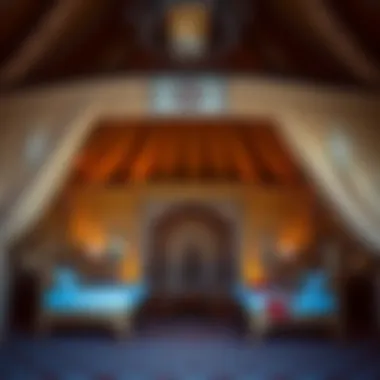
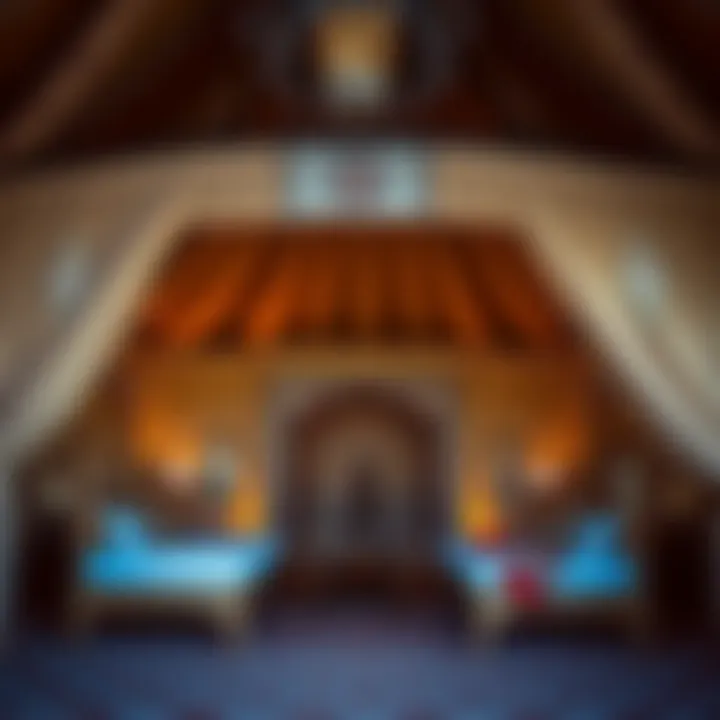
The Bedouin oasis camp is more than just a temporary shelter; it is a microcosm of Bedouin life and culture. Understanding the key elements of these camps reveals not only the practicality of living in harsh desert environments but also the deep cultural ties and social bonds that make the experience enriching for both guests and hosts. Key components such as traditional tents, community spaces, and decorative aspects play essential roles in creating this unique setting.
Traditional Tents
At the heart of every Bedouin oasis camp are the traditional tents, known as bayt al-sha’ar, made from goat hair and woven fabric. These black tents, with their distinctive striped patterns, serve as a testament to the nomadic lifestyle and the ability of Bedouins to adapt to the desert's harsh conditions. The use of goat hair provides natural insulation, keeping the interior cool during scorching days and warm during chilly nights.
Tents are not merely physical structures; they embody hospitality and protection. They are a place for family gatherings, storytelling, and cultural rituals. When a visitor enters a traditional Bedouin tent, it is customary to be welcomed with qahwa, a fragrant coffee that symbolizes friendship. This gesture illustrates the role of the tent as a social hub, connecting people and cultures.
Community Spaces
Community spaces within the oasis camp play a crucial role in enhancing interaction and fostering a sense of belonging. These areas are often designed to nurture relationships among visitors and between hosts. Open-air gathering spots, such as shaded courtyards and communal fire pits, provide an environment where stories are exchanged and friendships blossom over shared meals.
Moreover, communal areas often feature benches or low seating arrangements, accommodating larger groups comfortably. This encourages participation in traditional activities like dabka, a folk dance that brings people together. By prioritizing community**, these spaces reflect Bedouin values of hospitality and kinship, allowing everyone to contribute to the collective experience.
Decorative Aspects
The decorative elements of the oasis camp are rich in symbolism and artistry, contributing to the overall ambiance and aesthetic charm of the environment. Traditional weavings, intricate patterns on cushions and rugs, and handmade pottery are just a few examples of how the Bedouins express their cultural identity through art. These decorations are often created by local artisans, promoting their craft and preserving age-old techniques.
Elements such as colorful fabrics used for tent adornments and patterns on doorways also play a role in signifying welcome and protection. Furthermore, lanterns and candles enhance the evening atmosphere, creating a magical experience under the vast desert sky.
Ultimately, the decorative aspects of the camp are not just for visual pleasure; they serve as storytelling tools, preserving the history and myths of the Bedouin people.
"The true spirit of a Bedouin oasis camp lies in its ability to blend tradition with community through simple yet profound elements."
In summary, the key elements of a Bedouin oasis camp — traditional tents, community spaces, and decorative aspects — are intricately connected to the Bedouin way of life. Each component invites participants into a world where culture, hospitality, and the rugged beauty of the surrounding desert create an unforgettable experience.
Experiencing Life at the Oasis Camp
Stepping into a Bedouin oasis camp is not just about lodging; it’s about immersing oneself into a world where tradition embraces hospitality. This section sheds light on how the everyday experiences within these camps serve as a candid reflection of Bedouin culture. From the moment you arrive, the atmosphere is charged with warmth and a sense of belonging that is hard to find elsewhere.
The significance of this experience transcends the physical realm, encompassing the values and customs of a people who have thrived in some of the world’s most challenging environments. With every element thoughtfully designed to facilitate connection, both with nature and fellow visitors, life at the oasis encompasses various communal practices, culinary delights, and artisan skills that enrich this journey.
Welcoming Practices
Upon arrival, guests often find themselves enveloped by the gentle hospitality characteristic of Bedouin culture. Hosts might present a traditional Arabic greeting—"Ahlan wa sahlan"—which can be translated as "Welcome," conveying a heartfelt invitation to share in their space. It’s customary to receive dates and Arabic coffee, both offered as symbols of friendship and goodwill.
The welcoming does not end there. As people gather around, they might find themselves in a circle, where stories flow as freely as the coffee. Hosts are keen to share tales of their ancestral legacy as well as the rich history of the area. Here, the lines between visitors and hosts blur, creating a shared atmosphere that feels both intimate and enriching. A cozy blanket wrapped around the shoulders not only shields against evening chill but also signifies the embrace of an unfamiliar yet inviting culture.
Culinary Traditions
Food within the oasis camp plays a pivotal role in enhancing the overall experience. Each bite tells a story, echoing the agricultural practices of the region. Common dishes like Mansaf, a lamb dish served over rice, showcases culinary techniques passed down through generations.
Guests not only partake in these meals but often participate in their preparation, learning the delicate art of cooking with local spices and techniques. Here are some essential elements of the culinary offerings that one might expect:
- Traditional Dishes: Varieties vary widely but tend to focus on lamb, chicken, and an array of grains and vegetables.
- Baked Goods: Freshly baked bread, often prepared in a traditional clay oven, becomes a daily staple.
- Fruits and Nuts: Locally grown dates, figs, and almonds provide a sweet finish to the meal, embodying the desert’s bounty.
The act of sharing these meals is significantly more than nourishment; it's a cornerstone of Bedouin community life, fostering connections and blending stories over a feast.
Craftsmanship and Artisanship
An integral facet of the Bedouin experience is the showcasing of local craftsmanship. Visitors often encounter artisans at work, creating beautiful items such as intricately woven rugs or handcrafted jewelry. This art isn’t merely decorative; it carries deep cultural significance and tells the narrative of the Bedouins' connection with the land.
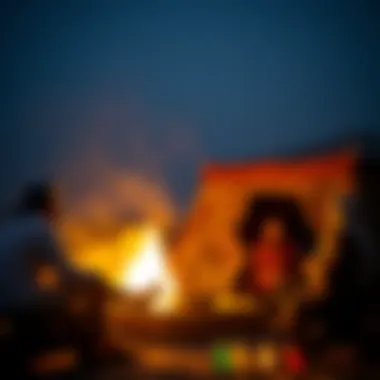

Here are some examples of craftsmanship seen in the oasis camps:
- Weaving Techniques: Utilizing natural fibers, the Bedouins’ weaving is both functional and artistic. Rugs and blankets made by hand demonstrate skills refined over countless years.
- Pottery and Ceramics: Skillful artisans shape clay into vibrant pots adorned with traditional designs, often used for storage or cooking.
- Jewelry Making: Utilizing local materials, Bedouin women often create stunning pieces that incorporate symbols of protection and prosperity.
Each artisan not only contributes to the economy of the oasis camp but also preserves the traditions that define the Bedouin identity.
In summary, the experiences at a Bedouin oasis camp form an intricate tapestry of welcoming practices, culinary delights, and artistry. These moments charge the ambiance with rich meaning, enabling a genuine interaction with a culture that invites guests to explore its profound depth. It's not merely observing; it's engaging, sharing, and celebrating life as the Bedouins have done for generations.
"Experiencing life at the oasis camp is like stepping back in time, where warmth embraces you and storytelling becomes a way of life."
By understanding these elements, visitors are better positioned to appreciate the layered nuances of the Bedouin heritage, making their stay a memorable and soulful experience.
For further exploration of Bedouin culture, visit Wikipedia or Britannica.
Moreover, you can find thriving discussions on social platforms like Reddit to gain insights shared by fellow travelers.
Whether you’re an investor looking at tourism potential, or a real estate agent considering the value of such cultural experiences, the oasis camp stands as a testament to sustainable, community-driven practices.
Activities and Adventures
When it comes to the Bedouin oasis camp experience, activities and adventures play a pivotal role in immersing visitors into a world steeped in rich tradition and natural beauty. These activities not only engage with the elements of nature but also reveal the essence of Bedouin culture through shared experiences. From traversing sand dunes to enjoying the art of local crafts, there's more to explore than meets the eye. Each element has its own unique benefits, drawing travelers into a deeper appreciation of this forgotten lifestyle, all while ensuring a sustainable approach that supports local livelihoods.
Desert Tours
One of the most compelling attractions of the Bedouin oasis camps is their desert tours. These excursions offer a chance to traverse the mesmerizing landscapes that define the region. Visitors might find themselves riding camels over rolling dunes or on 4x4 vehicles, experiencing the vastness of the desert firsthand.
- Expect surprises: Imagine a ride that takes you to hidden oases, where cool water and lush palm trees contrast sharply with the arid environment that surrounds them. The tour guides, often Bedouins themselves, share stories of their ancestors, adding layers of history to the sandy backdrop.
- Flora and Fauna: The guides can also point out local wildlife and plants, turning a simple journey into a lesson about the ecosystem. Travelers are often encouraged to take pictures, but they are reminded to tread lightly, respecting the delicate surroundings.
"Traveling through the desert is like peeling back the layers of time; every grain of sand tells a different story."
Cultural Performances
Cultural performances at the oasis camps provide an authentic glimpse into Bedouin life and traditions. Gathered around a fire, visitors might enjoy traditional music and dance, showcasing rich oral histories that have survived generations.
- Dances and Rhythms: Engaging performances highlight the significance of songs that were historically used to tell tales of love, war, and everyday life. Such interactions foster an emotional connection, allowing visitors to appreciate the struggles and joys embedded in these stories.
- Craftsmanship in Action: Some displays include local artisans crafting goods using techniques passed down over centuries, giving visitors insight into everyday Bedouin pursuits.
Stargazing Nights
As day gives way to night, the Bedouin oasis camp transforms yet again. Stargazing nights offer an unparalleled experience of the cosmos unfurling above. The clear desert skies are free from the pollution of urban life, creating an ideal backdrop for nights that feel almost otherworldly.
- Cosmic Perspective: Participants have the chance to lie on traditional carpets, gazing up at the constellations, some of which are deeply intertwined with Bedouin folklore. Learning about these celestial stories adds a layer of depth to the experience.
- Guided Telescopic Views: Some camps even provide telescopes for a closer look at planets and stars, merging education with awe. This setting serves not just as a leisure activity, but a moment of reflection and tranquility amidst the vast desert expanse.
In essence, activities and adventures offered at the Bedouin oasis camp encapsulate the beauty of a life intertwined with nature and culture. Each experience beckons visitors to participate, learn, and reflect, fostering an appreciation for both the heritage of the Bedouins and the stunning environment in which they thrive.
Sustainable Tourism and Its Impact
The notion of sustainable tourism takes on a significant meaning within the context of the Bedouin oasis camp experience. This approach is not just a modern buzzword; it embodies a commitment to balancing the economic, social, and environmental facets of tourism. For investors and real estate professionals interested in developing or supporting tourism initiatives, understanding sustainable practices in the Bedouin realms can unveil new opportunities and responsibly foster local cultures.
Promoting Local Economy
At the heart of any thriving oasis camp is the local economy. Sustainable tourism promotes local businesses by creating job opportunities, driving demand for handmade crafts, and enhancing food production. Rather than siphoning profits away, responsible tourism encourages a cycle of investment back into the community.
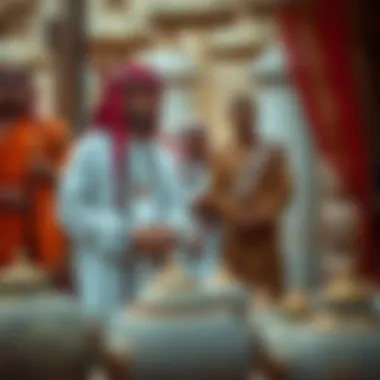
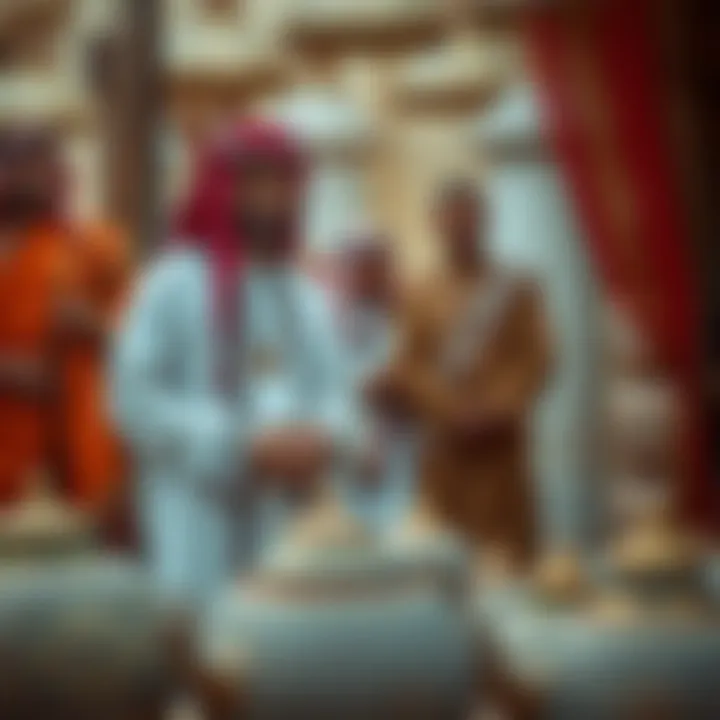
For instance, as travelers embark on their desert adventures, they may partake in traditional activities like camel riding or artisanal workshops. These experiences directly benefit local artisans and farmers, enabling a wide distribution of wealth that keeps the heritage alive. Interestingly, reports indicate that glowing reviews on social platforms enhance the visibility of local businesses, which in turn attracts more visitors to these remote areas.
- Local Impact: The spending power of tourists helps to augment the income of local families, promoting an improved quality of life.
- Cultural Preservation: Tourists participating in local customs help in keeping traditions alive, ensuring that these rich customs are passed on to future generations.
By fostering a symbiotic relationship between visitors and locals, the Bedouin oasis camps can ensure that tourism is a boon rather than a burden.
Environmental Considerations
The desert environment is delicate and requires mindful management to sustain its unique ecosystems. Sustainable tourism embraces the philosophy of leaving minimal footprints behind. This is especially important in the arid landscapes where Bedouin camps are often situated.
Environmental considerations include practices like:
- Water Conservation: With water being a scarce resource in the desert, camps often utilize techniques like rainwater harvesting and greywater recycling. Tourists are educated about the significance of water, instilling an appreciation of its value.
- Waste Management: Camps implement stringent waste management procedures, encouraging recycling and reducing single-use plastics. Visitors may find eco-friendly alternatives throughout their stay.
- Wildlife Protection: Many oasis camps promote initiatives to conserve the local flora and fauna, often incorporating tours that educate guests on the delicate ecosystems of the desert while maintaining respect for wildlife.
"Sustainable practices not only enrich the traveler’s experience but also ensure the preservation of the land and culture for generations to come."
In summary, sustainable tourism within the Bedouin oasis camp experience represents a melding of tradition and modernity. For buyers and investors seeking to tap into this realm, connecting with these principles provides a pathway not just to profit, but to making positive impacts on local communities and the environment. Embracing sustainable tourism can turn a simple visit into a meaningful journey.
Modern Adaptations of the Bedouin Camp
The oasis camp experience has undeniably evolved over the years. These adaptations are significant as they not only keep the essence of Bedouin culture alive but also cater to current expectations and desires for comfort and luxury. The dynamic interaction between tradition and modernity in Bedouin camps complements the growing interest in sustainable tourism. As a bridge connecting the past and present, the modern Bedouin camp offers both retreat and adventure to those who visit. Understanding these adaptations can help investors, homebuyers, and real estate agents grasp emerging opportunities in the field of hospitality and tourism.
Incorporating Luxury Elements
The infusion of luxury into the traditional Bedouin camp experience is a remarkable trend. Many camps now include en-suite bathrooms, air conditioning, and elegant furnishings. Instead of simply a tent, accommodations have transformed into plush capsules designed for comfort without compromising on the cultural aesthetic.
For instance, consider the addition of spacious lounge areas with plush carpets and artisan-crafted furniture. Such spaces draw on traditional designs, but now incorporate amenities like minibars stocked with local delicacies and international beverages. This blend of opulence and tradition creates a unique experience, which appeals to travelers looking for both authenticity and comfort.
- Spa services might offer relaxation and rejuvenation through natural therapies that utilize local herbs and essential oils.
- Fine dining experiences reflect local cuisine but often with a gourmet twist, giving a modern flair to ancient dishes.
This modernization not only draws higher-end clientele but also encourages longer stays and increased overall satisfaction.
Technological Innovations
As the world turns more digital, Bedouin camps have not been left behind. Integrating technology improves the overall visitor experience while still retaining a connection to the surrounding environment. Wi-Fi access, though unconventional for an authentic desert experience, has become increasingly common, allowing guests to stay connected.
Moreover, many camps now utilize solar power for electricity. This eco-friendly approach not only meets modern energy needs but also minimizes the environmental impact, aligning with sustainability goals that are gaining importance in the tourism sector.
Here are some notable technological advancements:
- Smart tents equipped with mobile charging stations and advanced lighting solutions that mimic natural light help enhance comfort.
- Interactive platforms allow guests to engage more deeply through things like cultural workshops, virtual desert tours, and even guided meditation sessions under the stars.
These innovations support the increasing demand for unique, immersive experiences while also appealing to environmentally conscious travelers, making them a win-win for both operators and visitors.
Culmination
The Bedouin oasis camp experience is more than just a temporary retreat; it’s a deep dive into a culture steeped in history, resilience, and community. As this article discussed, the importance of understanding the various elements that comprise these camps provides a wealth of knowledge for those exploring real estate opportunities or simply seeking an authentic experience. Investors and homebuyers can glean insights into how traditional values interact with modern adaptability, shaping not only the living environment but also the potential return on investment.
Reflecting on the experience of visiting a Bedouin oasis camp reveals a tapestry of cultural practices that shape the identity of these communities. This is not about simple tourism; it's a way to engage with the land and its people. The art of hospitality, the culinary traditions, and the craftsmanship all play a pivotal role in inviting outsiders to not just view but immerse themselves in what it means to be part of this rich heritage.
However, considering the future of Bedouin oasis camps unveils even more layers of significance. As societies evolve, so too do the needs and expectations of those who seek out these cultural encounters. Incorporating luxury elements and technological advancements not only preserves the integrity of Bedouin culture but also enhances the appeal for international tourists and potential residents. This makes the Bedouin oasis camp a living example of how heritage can thrive alongside progress.
"To understand the future of Bedouin oasis camps is to grasp the balance between tradition and innovation."
In summation, the Bedouin oasis camp is a vital linkage between the past and the contemporary world. The experience provides invaluable insights that resonate with those who appreciate the nuances of culture, sustainability, and community living. By fostering a deeper understanding, we not only appreciate the beauty of these spaces but also consider the potential they hold for future endeavors, both from an investment standpoint and as a blueprint for sustainable living in harmony with nature.
This layered perspective ensures that the Bedouin oasis camp remains a relevant and compelling discussion point in realms such as real estate, culture preservation, and tourism development.















